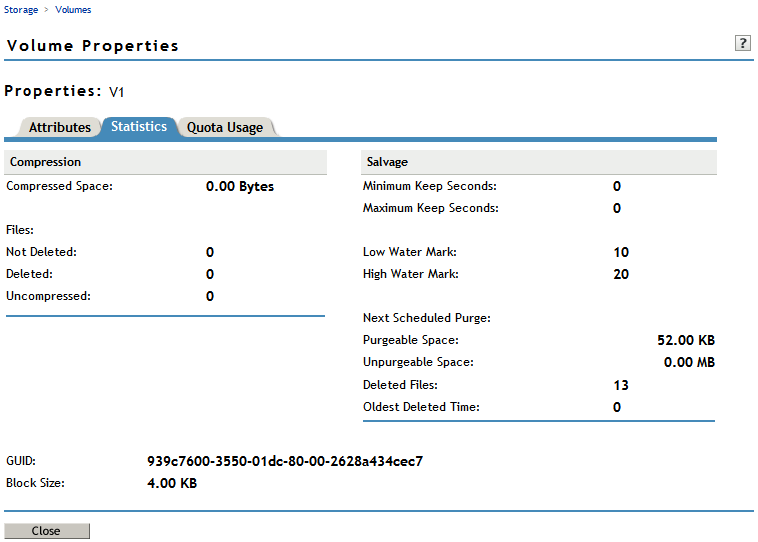28.2 Monitoring Compression and Salvage Statistics
For each volume, the page in iManager reports statistics about the compressed and salvageable files in the volume, the GUID of the volume, and the block size being used.
-
In iManager, click .
For instructions, see Section 9.1.5, Accessing Roles and Tasks in iManager.
-
Select a server to manage.
For instructions, see Section 9.1.6, Selecting a Server to Manage.
-
In the list, select a volume that you want manage.
-
Click .
The page has three tabs: , , and . It opens by default to the tab.
-
Click the tab to view the compression and salvage statistics for the selected volume.

If the compression attribute is set, the Compression report shows statistics of all the compressed files for the selected volume.
Statistic
Description
Compressed Space
The amount of space in the volume in use by compressed files.
Files
The total number of files in the volume and information by the following categories:
-
Not Deleted: The total number of files in the volume that are currently available to users.
-
Deleted: The total number of files in the volume that are deleted but not yet purged from the system.
-
Uncompressed: The total number of files in the volume that are not stored in compressed form.
If the Salvage Files attribute is enabled, the Salvage report shows statistics about deleted files that have not yet been purged.
Statistic
Description
Minimum Keep Seconds
Minimum time (in seconds) to keep deleted files.
Maximum Keep Seconds
Maximum time (in seconds) to keep deleted files.
Low Water Mark
If the amount of free space drops below this percentage, the file system begins purging deleted files.
High Water Mark
If there are files to delete, the autopurging process stops when the amount of free space reaches this percentage.
Next Scheduled Purge
Date and time of the next purge.
Purgeable Space
Amount of space in the volume that is occupied by deleted files that are queued for purging.
Unpurgeable Space
Amount of space in the volume that is occupied by files.
Deleted Files
The number of deleted files in salvage.
Oldest Deleted Time
Time line for deleted files. The file system purges the files in the same order they were deleted.
GUID
The Global Unique Identifier (GUID) number that NSS assigns to the volume. This number is necessary so your file system can locate the specific volume.
Block Size
The maximum amount of data committed to a single write process. Possible sizes include 4, 8, 16, 32, or 64 KB.
Other information reported includes the volume’s GUID and block size.
Statistic
Description
GUID
The Global Unique Identifier (GUID) number that NSS assigns to the volume. This number is necessary so your file system can locate the specific volume.
Block Size
The maximum amount of data committed to a single write process. Possible sizes include 4, 8, 16, 32, or 64 KB.
-